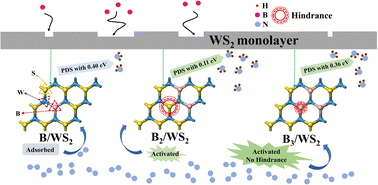Computational investigation of single and multiple boron atom doped WS2 monolayers for superior electrocatalytic reduction of nitrogen†
Abstract
The efficient conversion of nitrogen into ammonia plays a significant role in our modern society. Therefore, the design and development of associated catalysts have become an area of major research interest. Nowadays, an increasing number of studies have been exploring single-atom or double-atom metal-free electrocatalysts for the N2 reduction reaction, where regulating the precise number of catalyst atoms anchored on the substrate posed a real challenge. Herein, with density functional theory (DFT) simulations, this study investigated the activity of single and multiple B atom doped monolayer WS2 catalysts and observed superior efficiencies for nitrogen fixation and reduction. Computational results reveal that these novel catalysts have excellent thermodynamic stability, suitable adsorption of N2, superior catalytic activity and high selectivity for the nitrogen reduction reaction. Notably, this study clearly illustrates that the steric hindrance arising from the adjacent atoms of catalytic sites can be an effective route for manipulating the catalytic performance, offering new insights for the synthesis of high efficiency catalysts. In summary, this series of novel boron doped monolayer WS2 catalysts does not require precise control of the number of catalytic atoms on the substrate, making their preparation easier.



 Please wait while we load your content...
Please wait while we load your content...